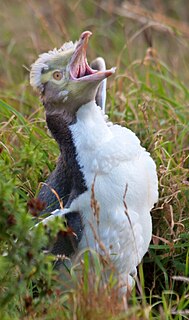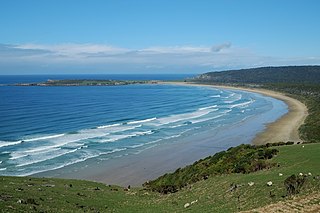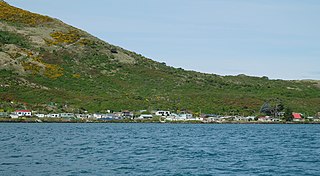
The University of Otago is a public university based in Dunedin, Otago, New Zealand. It scores highly for average research quality, and in 2006 was second in New Zealand only to the University of Auckland in the number of A-rated academic researchers it employs. In the past it has topped the New Zealand Performance Based Research Fund evaluation.

The Otago Peninsula is a long, hilly indented finger of land that forms the easternmost part of Dunedin, New Zealand. Volcanic in origin, it forms one wall of the eroded valley that now forms Otago Harbour. The peninsula lies south-east of Otago Harbour and runs parallel to the mainland for 20 km, with a maximum width of 9 km. It is joined to the mainland at the south-west end by a narrow isthmus about 1.5 km wide.

Otago Harbour is the natural harbour of Dunedin, New Zealand, consisting of a long, much-indented stretch of generally navigable water separating the Otago Peninsula from the mainland. They join at its southwest end, 21 km (13 mi) from the harbour mouth. It is home to Dunedin's two port facilities, Port Chalmers and at Dunedin's wharf. The harbour has been of significant economic importance for approximately 700 years, as a sheltered harbour and fishery, then deep water port.

The yellow-eyed penguin, known also as hoiho or tarakaka, is a species of penguin endemic to New Zealand.

The erect-crested penguin is a penguin endemic to the New Zealand region and only breeds on the Bounty and Antipodes Islands. It has black upper parts, white underparts and a yellow eye stripe and crest. It spends the winter at sea and little is known about its biology and breeding habits. Populations are believed to have declined during the last few decades of the twentieth century, and the International Union for Conservation of Nature has listed it as being "endangered".

The Snares penguin, also known as the Snares crested penguin and the Snares Islands penguin, is a penguin from New Zealand. The species breeds on the Snares Islands, a group of islands off the southern coast of the South Island. It is a yellow-crested penguin, with a size of 50–70 cm (19.5–27.5 in) and a weight of 2.5–4 kg (5.5–8.8 lb). It has dark blue-black upper parts and white underparts. It has a bright yellow eyebrow-stripe which extends over the eye to form a drooping, bushy crest. It has bare pink skin at the base of its large red-brown bill.

The Fiordland penguin, also known as the Fiordlandcrested penguin, is a crested penguin species endemic to New Zealand. It currently breeds along the south-western coasts of New Zealand's South Island as well as on Stewart Island/Rakiura and its outlying islands. Because it originally ranged beyond Fiordland, it is sometimes referred to as the New Zealand crested penguin.

Megadyptes is a genus of penguin from New Zealand.

The South Island takahē, also known as the notornis, is a flightless swamphen indigenous to New Zealand, and the largest living member of the rail family. It was hunted extensively by Māori, but was not named and described by Europeans until 1847, and then only from fossil bones. In 1850 a living bird was captured, and three more collected in the 19th century. After another bird was captured in 1898, and no more were to be found, the species was presumed extinct. Fifty years later, however, after a carefully planned search, takahē were dramatically rediscovered in 1948 by Geoffrey Orbell in an isolated valley in the South Island's Murchison Mountains. The species is now managed by the New Zealand Department of Conservation, whose Takahē Recovery Programme maintains populations on several offshore islands as well as Takahē Valley. It has now been reintroduced to a second mainland site in Kahurangi National Park. Although takahē are still a threatened species, their NZTCS status was downgraded in 2016 from Nationally Critical to Nationally Vulnerable. The population is 418 and is growing by 10 percent per year.

The Catlins comprises an area in the southeastern corner of the South Island of New Zealand. The area lies between Balclutha and Invercargill, straddling the boundary between the Otago and Southland regions. It includes the South Island's southernmost point, Slope Point.

Taiaroa Head is a headland at the end of the Otago Peninsula in New Zealand, overlooking the mouth of the Otago Harbour. It lies within the city limits of Dunedin. The nearest settlement, Otakou, lies three kilometres to the south.

Tautuku Peninsula is a rocky headland in the Catlins on the south coast of Otago on the South Island of New Zealand. It is located 25 km (15 mi) east of Waikawa, at the western end of Tautuku Bay.

The settlement of Harington Point lies within the boundaries of the city of Dunedin, New Zealand. It is located at the Otago Heads, at the northeastern end of Otago Peninsula, close to the entrance of Otago Harbour. The mouth of the harbour is at its narrowest at Harington Point, only some 400 metres separating the point from the mudflats at Aramoana on the opposing coast.

Sandfly Bay is a sandy bay with large dunes 15 kilometres (9.3 mi) east of central Dunedin, New Zealand. Located on the southern side of Otago Peninsula, between Seal Point and the Gull Rocks on the western side of Sandymount, Sandfly Bay is a Department of Conservation wildlife reserve frequented by trampers.
Lancelot Eric Richdale was a New Zealand teacher and amateur ornithologist.

David Eggleton is a New Zealand poet, critic and writer. Eggleton has been awarded the Ockham New Zealand Book Award for poetry and in 2019 was appointed New Zealand Poet Laureate, a title he holds until 2022. Eggleton's work has appeared in a multitude of publications in New Zealand and he has released over 18 poetry books with a variety of publishers, including Penguin.

Zelandoperla maungatuaensis, commonly known as the Maungatua stonefly, is a species of flightless stonefly so far known only from a single mountainside in Otago, New Zealand.

Allans Beach is a white sand beach on the Pacific Ocean coast of Otago Peninsula, in the South Island of New Zealand. It forms the seaward shore of a large spit at the entrance to Hoopers Inlet. Allans Beach is 25 kilometres (16 mi) by road from Dunedin city centre and 6 kilometres (3.7 mi) from the small town of Portobello. It receives little human traffic but is known to trampers, surfers, and naturists.

Lloyd Spencer Davis is a New Zealand-based author, filmmaker, scientist and science communicator. Born in Napier in 1954, he is known particularly for his creative nonfiction writing about science and nature subjects. He has published ten books and been co-editor of another two, as well as authoring over 150 scientific papers.
Yolanda van Heezik is a New Zealand academic and a professor of zoology at the University of Otago. She is considered one of New Zealand's first urban ecologists.


















